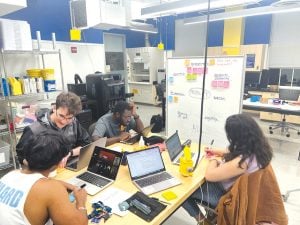


More than 600 Whiting School of Engineering students participated in this year’s Design Day, the school’s annual celebration of innovation and creativity. Held on May 1, the event showcased students’ ability to apply theoretical knowledge gained in classrooms and laboratories to real-world problems.
This year’s projects ranged from an acoustic device designed to attract (and track) oysters in the Chesapeake Bay to a migraine-fighting electrostimulation headband to an AI system to detect flaws in fabric used to make uniforms for the U.S. military—and much more, including:
Dampening Dental Drill Din
A team of mechanical engineering students worked with a Florida dentist to develop a device that dampens the buzzing and sometimes frightening sound of the drill used during procedures such as root canals (above left). Using an anatomical skull and their own mouths as sound conductors, the students created a bite plate that uses the same technology as noise-canceling headphones. The device picks up vibrations and produces an “anti-noise” wave; an attached controller allows the patients to adjust during treatment.
Flexing Mussels for Water Quality
A team of environmental health and engineering students worked with Baltimore City to develop a plan to install mussel beds in Back River (top right) and oyster beds in the Patapsco River. The shellfish, which will be nursed in cages before being transferred to reefs downstream, will serve as natural filters, reducing nutrient pollution in the water.
Analyzing Everyday Motion to Track Parkinson’s Progress
Biomedical engineering students have developed a signal-processing algorithm to help clinicians understand how well medication is working for patients with Parkinson’s, a neurodegenerative disease that affects an estimated 9 million patients worldwide (above bottom). Using small motion-tracking devices called inertial measurement units (IMUs), the team will record patients’ movements as they complete everyday tasks, such as brushing their teeth or writing with a pen.




